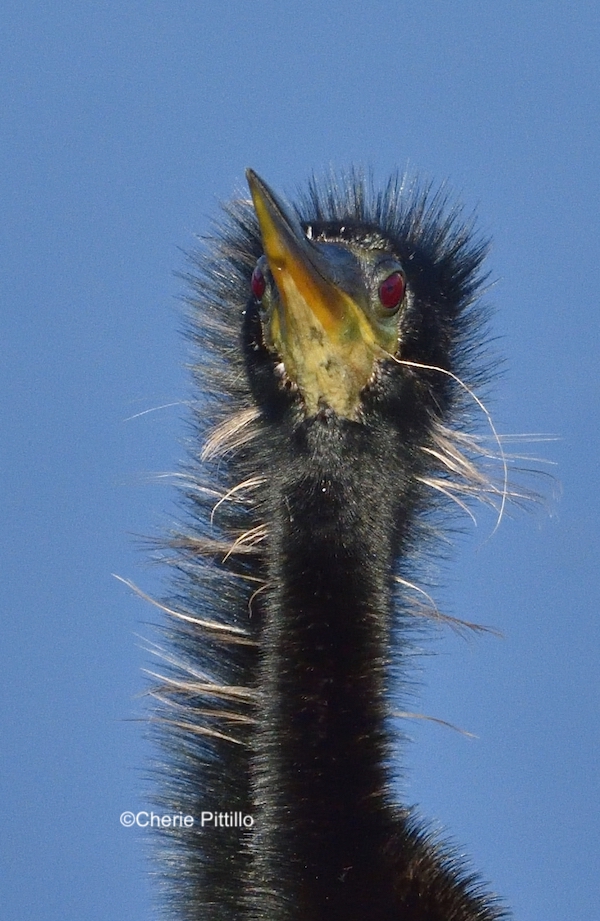
1. Red Eyes The Anhinga’s red eyes help it see shapes better underwater. Like many birds, a third eyelid, the nictitating membrane, protects the eye, cleans the surface cornea, and keeps it moist. However this membrane in some aquatic birds, including the Anhinga, has a central window that acts like a contact lens.

2. Alula Like slats or flaps on airplane wings, the alula, located at the bend of a wing, contains three to five asymmetrical feathers, which aid in preventing a stall during slow or steep flight. The Anhinga has a longer alula than other birds. Research indicates the alula tip forms a vortex of air which is forced back over the wing surface. It aids in support for turns and gentle landings.


3. Tomial “teeth” Tomia refer to the cutting edges of the beak and vary depending on the species. In the Anhinga, these tomial “teeth” aid in holding slippery prey such as fish. Note how the “teeth” point backward. Reminds you of a snake mouth, perhaps?


4. Tail corrugations Adults have corrugations on some tail feathers along with one feather on each wing. They may serve like tire treads to prevent sliding during underwater turns.

5. Totipalmate (sounds like a good friend, my toti-pal-mate) Anhinga can climb a tree or other perch using four strong, curved claws on its webbed feet, throwing its neck over a limb, and use its tail as support just like a woodpecker tail braces on the side of a tree. When threatened, even three week old chicks can drop out of a nest into water, and then climb up to their nest. By the way, those feet vary in color from bright yellow during courtship to yellow to black or mixed with both colors. Note the fourth toe is at an angle to the other three webbed toes (totipalmate.)

6. Throat skin During courtship male and female sport blue facial skin, and longer neck feathers but the female also has black throat skin. At non-breeding the female neck feathers are shorter and her head, neck and chest can vary from brown to rusty brown. The male lacks the blue and has shorter neck feathers.


7. Thermoregulation As much as we want to think the Anhinga is merely drying or sunning its wet wings, it has a low metabolism and loses body heat. Scientists theorize their spread-wing display with their backs to the sun typically is mainly for thermoregulation. By the way, those white feathers are black until they’re dry.


8 Melanin The pigment, melanin, adds strength and black color to the inside throat tissues of the parent. What a great adaptation because the chick inserts its head and neck into the parent’s throat. I’ve always wondered how a parent’s throat isn’t pierced as the young are aggressive to be fed!


9. Owl Face From the back an Anhinga chick looks like a giant owl face and may scare away predators. Some predators may not attack prey watching them.

10. Preen Gland The Anhinga has a well-developed preen gland. Many resources state that the oil gland doesn’t exist. Ignore those nay-sayers. This species squeezes the oil gland with the bill tip first and then rubs its chin and top of head to gather the oil to spread on its body and the leading edges of it wings.

GIVE NATURE A CHANCE TO UNFOLD HER UNCOMMON FEATURES.
MERRY CHRISTMAS, FELIZ NAVIDAD, HAPPY HANUKKAH, HAPPY KWANZAA, BUONE FESTE NATALIZIE, KURISUMASU OMEDETO, JOYEUX NOEL, FROEHLICHE WEIHNACHTEN, FELIZ NATAL, KRISMASI NJEMA, SAWAT DEE WAN, AND HAPPY HOLIDAYS
DISCLAIMER: REFERENCES DO NOT ALWAYS AGREE ON INFORMATION:
The Handbook of Bird Biology, Sal a Pajarear Yucatán, Bird & Reserves of the Yucatan Peninsula, A Guide to the Birds of Mexico and North Central America, A Dictionary of Birds, The Sibley Guide to Birds, Lives of North American Birds
Personal communication with Dr. Jerry Jackson, Professor Emeritus, Florida Gulf Coast University
https://www.sciencedaily.com/releases/2015/06/150605103008.htm
https://birdsoftheworld.org/bow/species/anhing/cur/introduction?login
https://web.stanford.edu/group/stanfordbirds/text/essays/Spread-Wing_Postures.html
https://animaldiversity.org/accounts/Anhinga_anhinga/
Cherie Pittillo, “nature inspired,” photographer and author, explores nature everywhere she goes. She’s identified 56 bird species in her Merida, Yucatan backyard view. Her monthly column features anecdotes about birding in Merida, Yucatan and also wildlife beyond the Yucatan.
Contact: [email protected] All rights reserved, ©Cherie Pittillo
